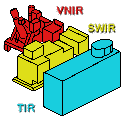|
|
The ASTER Clickable Instrument
 |
The ASTER
instrument consists of three separate instrument subsystems. Each
subsystem operates in a different spectral region, has its own telescope(s),
and was built by a different Japanese company. ASTER's three subsystems
are: the
Visible and Near Infrared (VNIR),
the Shortwave Infrared (SWIR),
and the Thermal Infrared (TIR).
To find out more about each module click on the item of interest.
|
ASTER Instrument Subsystems
The VNIR subsystem operates in three spectral bands at visible and near-IR wavelengths,
with a resolution of 15 m. It consists of two telescopes--one nadir-looking with a
three-spectral-band detector, and the other backward-looking with a single-band detector.
The backward-looking telescope provides a second view of the target area in Band 3 for
stereo observations. Thermal control of the CCD detectors is provided by a
platform-provided cold plate. Cross-track pointing to 24 degrees on either side of the
track is accomplished by rotating the entire telescope assembly. Band separation is
through a combination of dichroic elements and interference filters that allow all three
bands to view the same ground area simultaneously. The data rate is 62 Mbps when all four
bands are operating. Two on-board halogen lamps are used for calibration of the
nadir-looking detectors. This calibration source is always in the optical path.

The SWIR subsystem operates in six spectral bands in the near-IR region through a
single, nadir-pointing telescope that provides 30 m resolution. Cross-track pointing (±
8.550) is accomplished by a pointing mirror. Because of the size of the detector/filter
combination, the detectors must be widely spaced, causing a parallax error of about 0.5
pixels per 900 m of elevation. This error is correctable if elevation data, such as a DEM,
are available. Two on-board halogen lamps are used for calibration in a manner similar to
that used for the VNIR subsystem, however, the pointing mirror must turn to see the
calibration source. The maximum data rate is 23 Mbps.

The TIR subsystem operates in five bands in the thermal infrared region using a single,
fixed-position, nadir-looking telescope with a resolution of 90 m. Unlike the other
instrument subsystems, it has a "whiskbroom" scanning mirror. Each band uses 10
detectors in a staggered array with optical bandpass filters over each detector element.
The maximum data rate is 4.2 Mbps. The scanning mirror functions both for scanning and
cross-track pointing (to ± 8.55 degrees). In the scanning mode, the mirror oscillates at
about 7 Hz and, during oscillation, data are collected in one direction only. During
calibration, the scanning mirror rotates 90 degrees from the nadir position to view an
internal black body. Because of the instrument's high data rate, restrictions have been
imposed so that the average data rate is manageable by the spacecraft data management
system. This restriction is a one-orbit maximum average rate of 16.6 Mbps and a two-orbit
maximum average rate of 8.3 Mbps, which results in approximately a 9.3% duty cycle.

Instrument
|